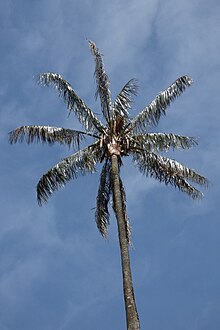Loading AI tools
Species of palm From Wikipedia, the free encyclopedia
Ceroxylon quindiuense, often called Quindío wax palm,[3] is a palm native to the humid montane forests of the Andes in Colombia and Peru.[4]

| Ceroxylon quindiuense | |
|---|---|
 | |
| At Armenia, Colombia. | |
| Scientific classification | |
| Kingdom: | Plantae |
| Clade: | Tracheophytes |
| Clade: | Angiosperms |
| Clade: | Monocots |
| Clade: | Commelinids |
| Order: | Arecales |
| Family: | Arecaceae |
| Genus: | Ceroxylon |
| Species: | C. quindiuense |
| Binomial name | |
| Ceroxylon quindiuense | |
| Synonyms[2] | |
| |
This palm species can grow to a height of 45 m (148 ft) —or rarely, even as high as 60 m (200 ft).[4] It is the tallest recorded monocot in the world.[5] The trunk is cylindrical, smooth, light colored, covered with wax; leaf scars forming dark rings around the trunk.[4] The leaves are dark green and grayish, 185–540 cm (6.1–17.7 ft) long, with a petiole up to 80 cm (31 in).[4] Fruits are globose and orange-red when ripe, 1.6–2 cm (0.6–0.8 in) in diameter.[4]
Ceroxylon quindiuense was described by Gustav Karl Wilhelm Hermann Karsten and published in Bonplandia (Hannover) 8: 70. (1860).[2]
Ceroxylon: generic name composed of the Greek words: kèròs = "wax" and xγlon = "wood", in reference to the thick white wax found on the trunks.[6] quindiuense: geographical epithet alluding to its location in Quindío.
It grows in large and dense populations along the central and eastern Andes of Colombia (rarely in the western Colombian Andes), with a disjunct distribution in the Andes of northern Peru.[4] The elevational range of this species is between 2,000 and 3,100 m (6,600 and 10,200 ft) above sea level.[4] It achieves a minimum reproductive age at 80 years.[3] Wax palms provide habitats for many unique life forms, including endangered species such as the yellow-eared parrot (Ognorhynchus icterotis).
Palma de cera, palma de ramo (both names in Colombia).[4]
Populations of Ceroxylon quindiuense are threatened by habitat disturbance, overharvesting and diseases.[3] The fruit was used as feed for cattle and pigs. The leaves were extensively used in the Catholic celebrations of Palm Sunday;[7] such leaves coming from young individuals which were damaged to death.[3] That activity has been reduced severely in recent years due to law enforcement and widespread campaign.[4] Felling of Ceroxylon quindiuense palms to obtain wax from the trunk also is an activity still going on in Colombia and Peru.[4] The palm is recognized as the national tree of Colombia, and since the implementation of Law 61 of 1985, it is legally a protected species in that country.[3][8]
The wax of the trunk was used to make candles, especially in the 19th century.[4] The outer part of the stem of the palm has been used locally for building houses, and was used to build water supply systems for impoverished farmers.[4][3] It is cultivated as an ornamental plant in Colombia and California.[4][3]
Seamless Wikipedia browsing. On steroids.
Every time you click a link to Wikipedia, Wiktionary or Wikiquote in your browser's search results, it will show the modern Wikiwand interface.
Wikiwand extension is a five stars, simple, with minimum permission required to keep your browsing private, safe and transparent.